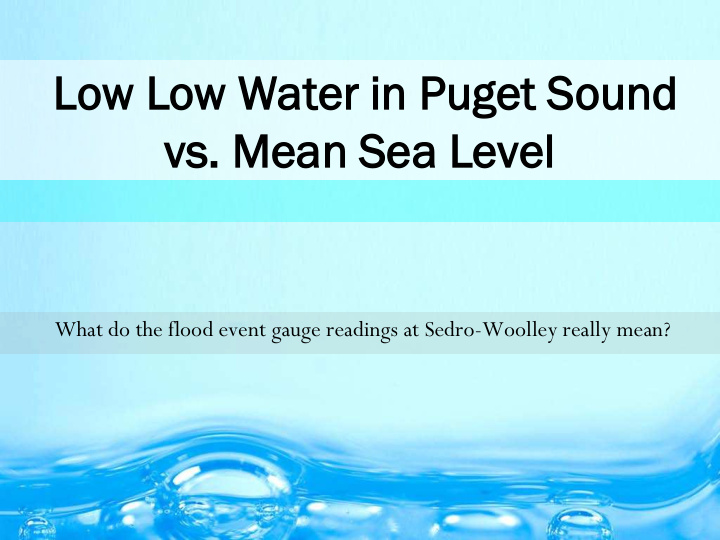



Low w Low w Wat Water in in Pug Puget So Sound und vs vs. Me . Mean S Sea Le Leve vel What do the flood event gauge readings at Sedro-Woolley really mean?
Back in 1928
Two Problems With the Numbers 1. The figures published are the same figures that Stewart used in his 1923 “Draft” report except that the Corps added 30 feet to Stewarts gage readings but those were based on Low Low Water in Puget Sound. 2. Low Low Water is NOT the same as Mean Sea Level.
Back to 1907
2,890 feet Below S-W Railroad Bridge
In 1961 Stewart-Bodhaine, USGS Published the Following The difference between Low Low Water/Extreme Low Sea Level in Puget Sound and Mean Sea Level.
Spot the Similarities 1961 Stewart-Bodhaine: 1928 Corps: Skagit River at S-W Skagit River at S-W
Subtracting 8.93 feet From Published Figures
August 2009 Corps Historical Flood Estimates Accounting for Dam Storage The 2003 flood event registered 42.02 (Mean Sea Level) on the Sedro ‐ Woolley gage. In 2006 it registered 42.2. SOURCE: Army Corps of Engineers Seattle District August 2009 Feasibility Scoping Meeting Read ‐ Ahead Report: http://www.SkagitRiverHistory.com/Corps Docs/2009-08-19 SKAGIT FSM Read-Ahead Final.pdf
Stewart’s Handwritten Calculations
So what datum did James E. Stewart use in his 1922 survey?
Page 1 of Stewart’s Notes Showing Sedro-Woolley Calculations
Which Leads Us To the Question Why is this all so important?
The Consequence Corps Seattle District Letter to Corps HQ Portland, Re: Flood Storage Behind Ross Dam, 13 August 1953 The next step was to determine the amount of storage required at Ross Reservoir to provide the maximum crest reduction at Sedro Woolley. All discharges of more than 65,000 second-feet at either Sedro Woolley ( 1908 through 1923 ) and Concrete ( 1924 to date ) occurring in October, November, and December were studied. We have been told repeatedly that Stewart’s Sedro-Woolley figures are not reliable, yet the Corps used those figures instead of the Concrete figures for the Stewart floods but used Concrete for all the rest of the floods.
Recommend
More recommend